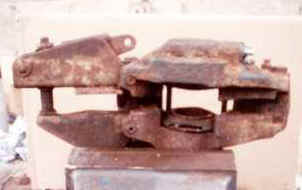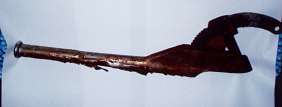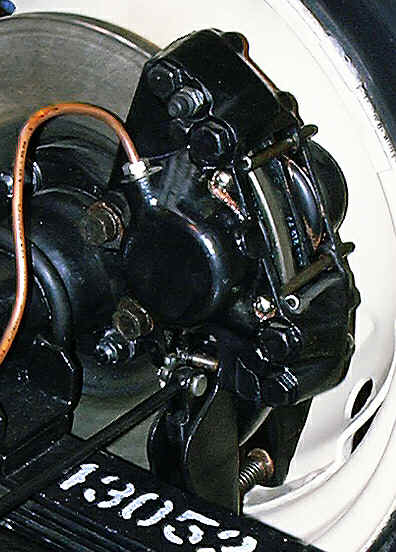REAR CALLIPERS AND HAND/BRAKE
I have now completed the overhaul of the rear braking system. As you can see from the picture the rear callipers were in a poor state, with the pistons being seized in the bores.
As you can see the rear calliper is a poor state.
I tried at first to force them out with an airline, but this proved unsuccessful. My next approach was hydraulic them out, this required the insertion of a grease nipple in place of the brake pipe. This allows a grease gun to be attached and applying the rule of hydraulics forces the pistons out of the bores, without the need to apply heat or splitting the callipers.The handbrake mechanism was dismantled and new pins were inserted, where the handbrake rods attach I drilled them out to the next size up. This removed any oval-ness that had occurred and gives a greater surface area over the clevis pins. The calliper bodies were painted with satin black calliper paint obtained from Frost (01706658619).
I cleaned up the bore with a bit of wet and dry then fitted new seals and stainless steel pistons, liberal amounts of rubber grease was applied to prevent further corrosion occurring before the system was refilled with fluid. Stainless steel braided hoses and copper brake pipe was then used throughout the remainder of the system. All replacement parts consisting of discs, hoses, handbrake cable, pistons and seal kits were obtained from David Manners. The Handbrake itself was in a shocking condition, the chrome was peeling off with the internals completely seized, and to make matters worse a poor repair had been made near to the fulcrum pin. After making several enquiry's it appeared that this handbrake was unique to the SP and they were unavailable. I eventually managed to strip it down and reinforce the area around the fulcrum pin, it was then sent off for re-chroming. On its return I reassembled it, only to discover I couldn't press the button in to apply the handbrake, after much head scratching it suddenly dawned that it was a fly off handbrake and was working perfectly (i.e. the button is pressed to engage the pawl and ratchet, not to disengage like on modern car) .
Next job was to fit the discs onto the rear hubs, and then to fit the hubs onto the half shafts. During assembly I smeared copper slip onto the taper of the shaft, this is to aid disassembly in the future. The hubs are also secured from spinning by keys. This completed the reassemble of the axle and its associated components. By now the conversion kit had arrived from New Zealand. It comprised of clutch and clutch cover, release bearing and carrier, clutch actuating fork, slave cylinder, spigot bearing adapter, Speedo cable rear gearbox mounting plate and assorted bolts.


